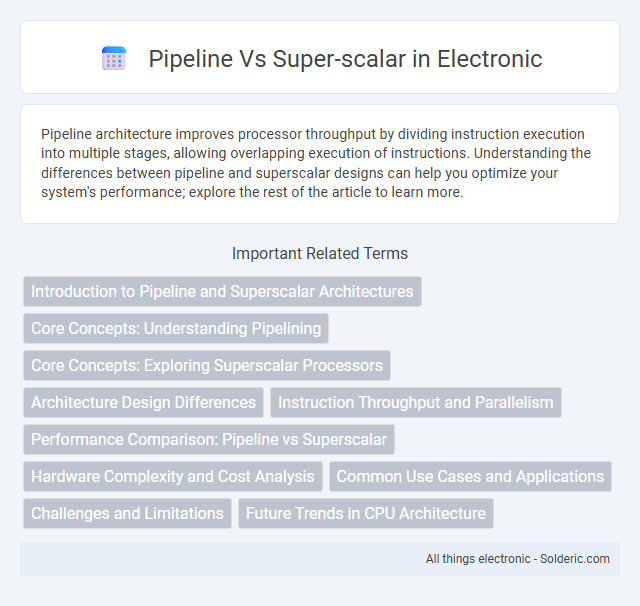Pipeline architecture improves processor throughput by dividing instruction execution into multiple stages, allowing overlapping execution of instructions. Understanding the differences between pipeline and superscalar designs can help you optimize your system's performance; explore the rest of the article to learn more.
Comparison Table
| Feature | Pipeline Architecture | Super-scalar Architecture |
|---|---|---|
| Definition | Executes multiple instruction stages sequentially in a overlapped manner. | Executes multiple instructions simultaneously using multiple execution units. |
| Instruction Throughput | Increases by processing different instruction stages concurrently. | Increases by issuing multiple instructions per clock cycle. |
| Execution Units | Typically single or limited units working in stages. | Multiple parallel execution units (ALUs, FPUs). |
| Complexity | Lower complexity, simpler control logic. | Higher complexity, requires instruction dispatch and issue logic. |
| Hazard Handling | Stalls pipeline or uses forwarding to resolve data hazards. | Dynamic scheduling and advanced hazard detection to avoid stalls. |
| Performance Gain | Improves cycles per instruction (CPI) by overlapping stages. | Improves instructions per cycle (IPC) by parallel execution. |
| Examples | Classic RISC processors (e.g., MIPS pipeline). | Modern CPUs (Intel Core, AMD Ryzen). |
Introduction to Pipeline and Superscalar Architectures
Pipeline architecture improves CPU performance by dividing instruction execution into distinct stages, allowing multiple instructions to overlap in processing simultaneously. Superscalar architecture enhances this concept by enabling multiple instructions to be issued, decoded, and executed in parallel within a single clock cycle, effectively increasing instruction throughput. Both designs aim to optimize instruction-level parallelism but differ in complexity and implementation, with pipelines focusing on sequential stage processing and superscalar leveraging multiple execution units.
Core Concepts: Understanding Pipelining
Pipelining in processor architecture divides instruction execution into discrete stages, allowing multiple instructions to overlap in execution and significantly improving throughput. Each pipeline stage handles a specific part of the instruction cycle, such as fetch, decode, execute, memory access, and write-back, enabling continuous instruction flow. This core concept reduces latency per instruction by breaking down complex tasks into simpler, sequential steps, contrasting with super-scalar designs that focus on parallel instruction issue from multiple execution units.
Core Concepts: Exploring Superscalar Processors
Superscalar processors enhance instruction-level parallelism by dispatching multiple instructions per clock cycle using multiple execution units, surpassing the linear instruction throughput of traditional pipelined architectures. Unlike pipeline designs that process instructions sequentially through discrete stages, superscalar cores dynamically issue and execute several instructions simultaneously, leveraging techniques like out-of-order execution and register renaming. This approach significantly boosts CPU performance by maximizing resource utilization and reducing instruction latency in modern microprocessors.
Architecture Design Differences
Pipeline architecture breaks instruction execution into sequential stages, allowing multiple instructions to overlap in different phases of processing, which enhances throughput but retains a single instruction at each stage. Superscalar architecture, by contrast, duplicates functional units to dispatch multiple instructions per clock cycle, enabling parallel execution beyond the pipeline's sequential flow. Your choice between these designs depends on balancing complexity, execution speed, and the ability to handle instruction-level parallelism.
Instruction Throughput and Parallelism
Pipelining increases instruction throughput by breaking down execution into discrete stages, allowing multiple instructions to overlap in different phases simultaneously. Super-scalar architectures enhance parallelism by issuing multiple instructions per clock cycle through several execution units, effectively processing several instructions concurrently. Your processor's overall performance gains when combining pipelining's stage overlap with super-scalar's multi-instruction dispatch capabilities.
Performance Comparison: Pipeline vs Superscalar
Superscalar architectures achieve higher performance than pipelines by executing multiple instructions per clock cycle through parallel functional units, increasing instruction-level parallelism beyond the single-instruction throughput of pipelines. Pipeline processors improve performance by breaking instruction execution into discrete stages, increasing clock frequency and instruction throughput but remaining limited to one instruction completed per cycle in ideal conditions. Your choice between pipeline and superscalar designs depends on application demands, as superscalar processors offer superior performance in software with high instruction parallelism, while pipeline processors provide simplicity and efficiency for less parallel workloads.
Hardware Complexity and Cost Analysis
Pipeline architecture increases hardware complexity by requiring multiple stages to handle different instruction phases simultaneously, leading to higher costs due to extensive control logic and forwarding mechanisms. Superscalar designs further complicate hardware by incorporating multiple execution units and dynamic scheduling to exploit instruction-level parallelism, significantly raising design complexity and manufacturing expenses. Your choice between pipeline and superscalar implementations should balance performance gains against the increased hardware cost and complexity inherent in superscalar processors.
Common Use Cases and Applications
Pipelines are commonly used in general-purpose CPUs to improve instruction throughput by executing multiple instruction stages simultaneously, ideal for applications requiring steady, consistent performance like embedded systems and mobile devices. Superscalar architectures excel in high-performance computing environments, such as gaming consoles, servers, and advanced scientific simulations, where parallel instruction issue boosts overall execution speed significantly. Your choice between pipeline and superscalar often depends on whether the focus is on energy efficiency and predictability or on maximizing processing power for complex, compute-intensive tasks.
Challenges and Limitations
Pipeline architecture faces challenges such as hazards including data, control, and structural hazards that can cause stalls and reduce instruction throughput. Super-scalar processors encounter limitations in instruction-level parallelism, as dependencies and resource conflicts restrict the number of instructions issued per cycle. Your system's performance may be constrained by the complexity of implementing out-of-order execution and branch prediction required to mitigate these challenges effectively.
Future Trends in CPU Architecture
Future trends in CPU architecture emphasize combining pipeline depth with superscalar execution to enhance parallelism and instruction throughput. Increasing pipeline stages improves clock speeds, while superscalar designs enable multiple instructions per cycle, balancing latency and performance. Your applications will benefit from adaptive architectures leveraging these techniques to optimize efficiency and power consumption in emerging workloads.
pipeline vs super-scalar Infographic

 solderic.com
solderic.com